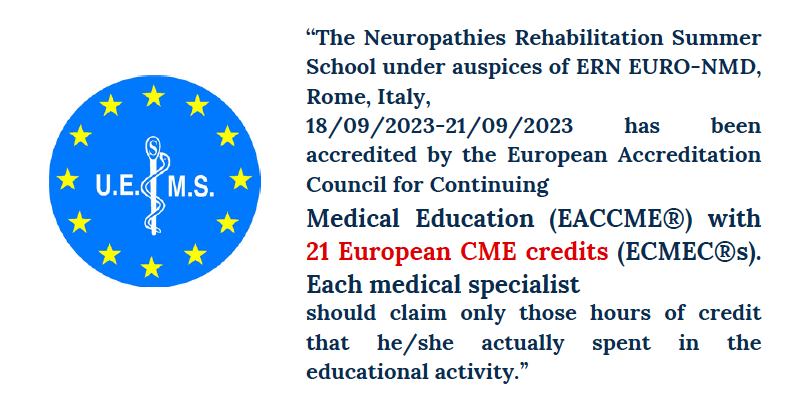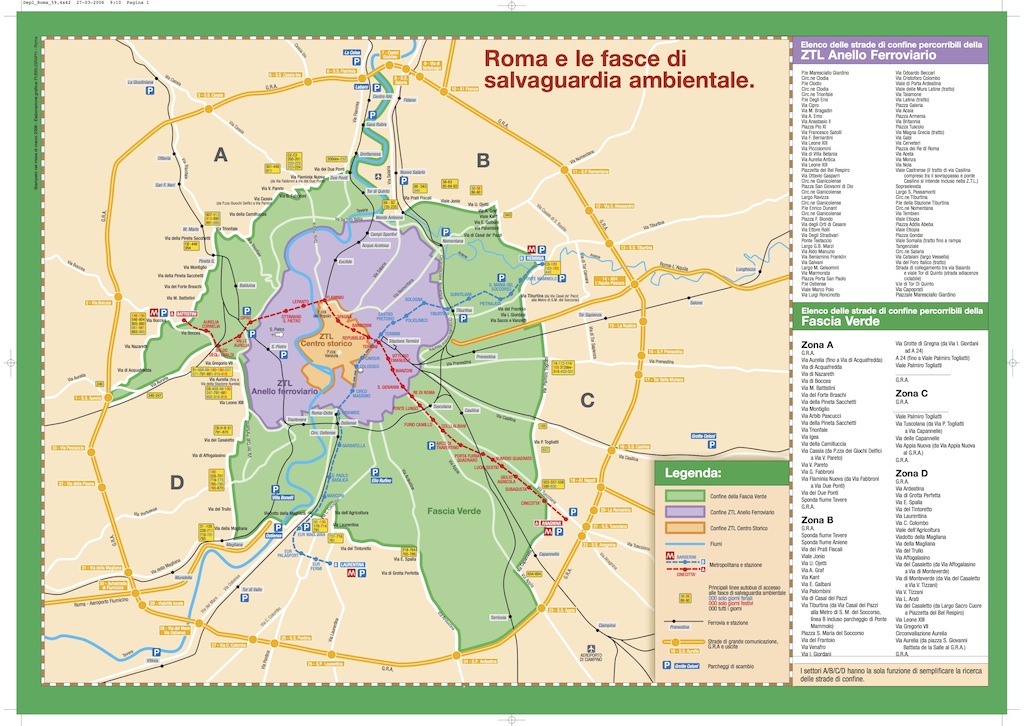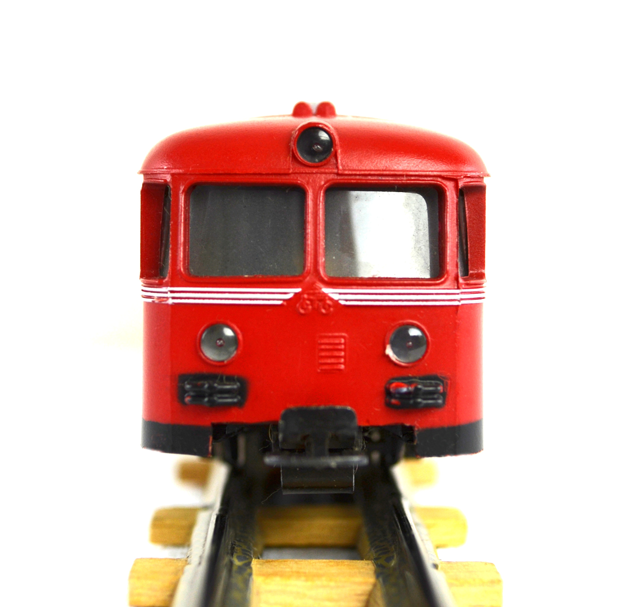The Neuropathies Rehabilitation Summer School, held under the auspices of ERN EURO-NMD, is a specialized event designed for physiotherapists, occupational therapists, clinicians with an interest in neuromuscular diseases, clinicians specializing in rehabilitation medicine, and patient advocacy groups. The primary objective of this summer school is to disseminate knowledge about current and future modalities of rehabilitation in rare and complex neuropathies.
The Neuropathies Rehabilitation Summer School will take place from September 18-21, 2023 in Hotel Excel Roma Montemario, Rome, Italy.

The expected educational outcome for attendees of a neuropathies rehabilitation Summer School, whose aim is to disseminate knowledge on current and future modalities of rehabilitation in rare and complex peripheral neuropathies, would be to acquire a comprehensive understanding of the subject matter and develop the skills necessary for effective rehabilitation in these conditions. Some specific educational outcomes could include:
By achieving these educational outcomes, attendees would be better equipped to contribute to the field of neuropathy rehabilitation, enhance their clinical practice, and improve the quality of care provided to patients with rare and complex peripheral neuropathies.
Over the course of two full days and two half days, the event aims to educate clinicians, researchers, physiotherapists, and patient advocacy groups working in the field of rehabilitation and neuromuscular diseases. The program covers a wide range of topics, including the basics of rehabilitation for peripheral neuropathies, new trends in rehabilitation medicine, innovative technological rehabilitation, and telerehabilitation. It also focuses on rehabilitation applied to specific peripheral neuropathies, emphasizing disease-specific sessions.
The disease-specific sessions at the summer school will address various neuropathies, including acute inflammatory neuropathies, chronic inflammatory neuropathies, sensory neuropathies, Amyloidosis, and Charcot-Marie-Tooth (CMT) disease. These sessions follow a structured format to provide comprehensive information. The first part focuses on disease characteristics and main symptoms, enabling participants to understand the specific neuropathies in depth. The second part explores the existing literature, highlighting evidence-based approaches to rehabilitation and relevant scales used in assessing patients’ progress. Finally, the third part delves into current practices and perspectives, showcasing the latest developments in rehabilitation for each specific neuropathy.
In addition to knowledge dissemination, the summer school also highlights the role of networks like EURO-NMD in facilitating the development of rehabilitation medicine. It emphasizes the importance of standards of care, outcome measures, and the ongoing efforts in clinical trials related to rehabilitation.
The Neuropathies Rehabilitation Summer School brings together a diverse audience of professionals and stakeholders, fostering collaboration and knowledge exchange in the field. By providing a platform for clinicians, researchers, therapists, and patient advocacy groups, the event aims to advance the understanding and application of rehabilitation techniques in the context of rare and complex neuropathies.
| Luca Padua (President) | Director of the Operative Unit of High Intensity Neurorehabilitation of the Fondazione Policlinico Universitario A. Gemelli IRCCS |
| Massimo Marra | Founder-CIDP ITALIA |
| Angelo Schenone | Director of the Clinical Neurology Unit, IRCCS San Martino Hospital and University of Genova |
| Davide Pareyson | Director of Rare Neurological Diseases Unit, Fondazione IRCCS Istituto Neurologico C.Besta (FINCB) of Milan |
| Jean-Philippe Plançon | President of European Patient Organization for Dysimmune and Inflammatory Neuropathies (EPODIN) |
| Teresinha Evangelista | Coordinator ERN EURO-NMD |
Rome—or Roma in Italian—is the capital of Italy. It is also the largest city in the country. Rome is without doubt one the most beautiful cities in the world; every year millions of tourists come from around the world to admire the treasures and masterpieces of Roman history, art and architecture. Rome has an immensely rich historical heritage, making it one of Europe’s world’s most visited, famous, influential and beautiful capitals. You will get to explore superb sightseeing, perfect palaces, grand romantic ruins and many more beautiful historic places that Rome provides. It is magnificent, marvellous and majestic.

The Italian capital has two airports. The main one, Fiumicino, is located around 30 km southwest of the city center. It is served by both traditional and low-cost airlines. The second airport, Ciampino, is mainly reserved for charter and low-cost airlines. It is less than 20 kilometers from the city center, to the southeast.


Car traffic in Rome’s historic center is prohibited from Monday to Saturday, from 6.30am to 6pm, and on Fridays and Saturdays from 11pm to 3am. Police controls are carried out by video surveillance cameras.
As a general rule, read traffic and parking signs carefully. ZTLs (limited traffic zones) are marked with an electronic VARCO ATTIVO sign. Do not enter if you are not authorized. Avoid the “zone preferenziali”, which are the equivalent of bus and cab lanes. Please note: these restrictions also apply to two-wheeled vehicles.
In accordance with European anti-pollution standards, you’re not allowed to drive in the mauve-colored ZTL “anello ferroviario” zone (excluding Saturdays, Sundays and public holidays) from Monday to Friday (check the Euro emission standards (Euro1, 2, etc.) of your car). In some cases, you’re not allowed to drive in the “fascia verde” zone.
The historic center of Rome is very walkable, but public transportation makes getting from one end of the city to the other much easier.
ATAC, Azienda per i Trasporti Autoferrotranviari del Comune di Roma, is Rome’s primary public transportation authority. It manages the wide network of metro lines, trams, and buses that moves thousands of locals and tourists in and around the city of Rome.

(VAT not requested for Extra UE Companies and VIES registered Companies)
PLEASE NOTICE
Whilst coffee breaks and lunches will be provided during the course, attendees must organise and pay for their own travel and accommodation




